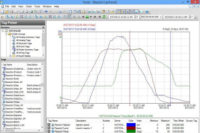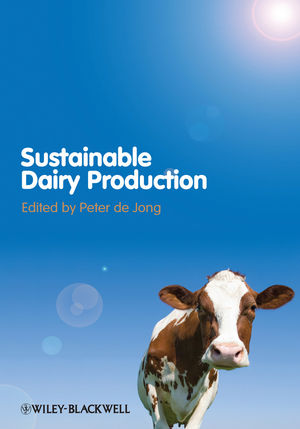Dairy Processors Learn To Move It
Plant managers use conveyors and robotic palletizers to reduce handling costs.
 It is not enough for dairy processors to make a great product. They need to get it off the line, on a pallet and out the door. That’s what conveyors and palletizers do. This equipment minimizes the bending and lifting that plant employees must do in moving crates and cases around. Conveyors and palletizers can save on labor costs, as employees are re-assigned to more high-value tasks. Or, the positions are eliminated.
It is not enough for dairy processors to make a great product. They need to get it off the line, on a pallet and out the door. That’s what conveyors and palletizers do. This equipment minimizes the bending and lifting that plant employees must do in moving crates and cases around. Conveyors and palletizers can save on labor costs, as employees are re-assigned to more high-value tasks. Or, the positions are eliminated.
Dairy processors running at or near capacity might find that they can increase output by re-arranging lines instead of building an addition or new facility.
“Both production volumes and the number of SKUs are increasing, requiring current floor space to be utilized to the fullest,” says Terry Zarnowski, director of sales and marketing for Schneider Packaging Equipment, Brewerton, N.Y. “The flexibility of robotic palletizing systems accommodates these increases without adding additional lines. An automated palletizing system can be laid out to be compatible with almost any current plant layout to minimize the distance to transport consumable materials.” He adds that this kind of “spatial economy” can significantly reduce handling costs and work in process by eliminating double handling, buffering and inventory.
Following are case studies of how some dairy processors are using automation in their facilities, plus a look at new equipment.
Case Study: Processor Installs ARB Switch
To Feed Two Milk Lines
Canélia, a milk producer based in Petit-Fayt, France, is part of Lactalis Group, the world’s second largest dairy company. At the Canélia bottling site, 1-liter polyethylene bottles of milk are shrink-wrapped in groups of six, eight or 10 at a throughput rate of 15,000 bottles per hour. The 8-liter and 10-liter packs are fed to the palletizer at the line’s maximum throughput rate. To meet new demands, the dairy needed to create a new pallet format as well as revise the arrangement of the bottles on each pallet layer, all the while maintaining throughput.
The dairy was using lateral side rail conveyance technology to feed the palletizer via one line. To achieve the new pallet format, however, two lines were required. As side rail technology required time-consuming adjustments to accommodate the different pack sizes, it was no longer a viable conveyance solution. Additionally, it was to blame for frequent jams and damage to the package shrink-wrap. So, Canélia consulted with the OEM integrator and Intralox for a better conveyance solution.
In a simulation, Intralox, Harahan, La., presented the activated roller belt (ARB) switch, an automated conveyance solution to feed the palletizer via two lines, requiring no adjustments for varying package types. The result is the elimination of the side rails (and the associated headaches). The Intralox switch optimized production throughput and enabled Canélia to meet market demand for various pallet sizes and arrangements.
“What’s remarkable about the ARB switch is its simplicity, as it continually, smoothly moves the products. This solution responded perfectly to our needs,” says Mathieu Agranier, head of production at the Canélia dairy.
Contributed by Intralox, a subsidiary of Laitram L.L.C. www.intralox.com
Case Study: Dean Foods, Kroger Find Label Verification System Results in Long-term Cost Savings
With the growing awareness of food allergies in both children and adults alike, and the increasing importance of correct nutritional information for those with special dietary needs, proper labeling has become one of the most important facets of food production and distribution.
When a retail grocer receives a two-truck shipment of milk from a dairy processing facility, every pallet is checked for the correct product labels. If even one pallet is labeled incorrectly, the entire shipment is returned to the distribution center and the product is deemed unsellable, resulting in a loss of tens of thousands of dollars for the processor. Grocery stores are not alone in their policy, as other major and minor retailers have begun to adapt this no-tolerance approach. Local and state governments also entered the discussion and begun passing new legislation to protect the consumers.
 Conveyor manufacturer Integrated Packaging Machinery, Comstock Park, Mich., developed a vision inspection system that is cost-effective for the dairy processing facility and user-friendly for their workers, with virtually no human interaction during use. The system identifies even the smallest inaccuracies and quickly segregates the suspect product from the finished goods. If five consecutive defects are flagged, the entire line can be stopped to limit costly waste and rework. Whether a label is missing, jammed, crooked or simply inaccurate for the product being run, the label verification system catches it. The worry of sending even one pallet (let alone a truckload) of incorrectly labeled milk is completely negated.
Conveyor manufacturer Integrated Packaging Machinery, Comstock Park, Mich., developed a vision inspection system that is cost-effective for the dairy processing facility and user-friendly for their workers, with virtually no human interaction during use. The system identifies even the smallest inaccuracies and quickly segregates the suspect product from the finished goods. If five consecutive defects are flagged, the entire line can be stopped to limit costly waste and rework. Whether a label is missing, jammed, crooked or simply inaccurate for the product being run, the label verification system catches it. The worry of sending even one pallet (let alone a truckload) of incorrectly labeled milk is completely negated.
The label verification systems have a small footprint, can be adapted to any manufacturing line and are used for a wide range of applications, including labeling, cap detection, date code verification and more. IPM’s systems were adapted by Dean Foods and Kroger for their dairy lines in 2010, resulting in long-term cost savings and enhanced relationships with their retail partners. Product that is incorrectly labeled in any way never makes it off the line.
Contributed by Integrated Packaging Machinery, www.callipm.com
Case Study: Empty-Case Handling System Improves Efficiency for Milk Processor in Canada
At Northumberland Dairy in New Brunswick, Canada, difficulties arose from the manual de-palletizing operation. The top-out de-stacking system was too slow to accommodate rising demand, and the case-washing system was old and inefficient. So, the dairy processor installed an automated empty-case handling system that includes a case stack de-palletizer, stack conveyors with 3-to-1 merging, a bottom-out de-stacker and wheel drives transferring cases overhead to a new case washer. Clean cases are then color sorted with a case-reject system, and accepted cases are transported to production on new cable conveyor system. Constructed of stainless steel, the entire system is suitable for washdown.
Northumberland operates with 16-quart plastic dairy cases on 40-inch by 40-inch pallets. The dairy chose equipment from Westfalia’s Deam Systems division, York, Pa.
From the point of entry where a forklift driver places a full pallet of seven-high case stacks onto the de-palletizer, the system is fully automated. Using clamp-and-lift technology and at a rate of two to three pallets per minute, the de-palletizer removes stacks from the pallet onto three stack conveyors, which merge into one conveyor leading into the de-stacking machine.
The bottom-out de-stacker operates at rates of up to 90 cases per minute and discharges cases onto a wheel drive that transfers them via a vertical up-chute to the new case washer on an overhead mezzanine.
After running through the new steam-cleaning washer, cases are conveyed on a cable conveyor through a color-sensing case-sorting unit. It pushes off rejected cases and releases to production accepted cases. The fully automated empty-case handling system enabled Northumberland to reduce labor costs associated with receiving and handling empty cases, achieve higher operating speeds and improve washing efficiency.
The de-palletizer features a full-color HMI with touch-screen and 330-degree swivel mount, providing operators easy access to the system controls. Safety of the staff is paramount, and the new de-palletizing system has full safety guarding with light curtain protection.
Contributed by Westfalia Deam System, www.WestfaliaUSA.com.
 A Combination Casepacker/Palletizer
A Combination Casepacker/Palletizer
Fits Into Compact Environments
Schneider Packaging Equipment Co.’s new case packer/palletizer cell is said to offer flexibility, compactness and production efficiency in dairy processing facilities with minimal floor space or low ceilings.
Equipped with a FANUC long-arm robot, the integrated case packer/palletizer automatically transfers pallets using a side-drive system that moves pallets into position at floor level, eliminating pallet conveying. The loaded pallets are then moved out of the system at floor level where they can be removed by a standard pallet jack or fork truck while the system continues to operate.
The design is based on Schneider’s award-winning Pack/Pal combination robotic cell in which cases are automatically erected, loaded, sealed, labeled and palletized in a single integrated unit occupying roughly a 240-square-foot footprint. The integrated pallet-side drive system minimizes floor space requirements while building full height pallets, even in low-ceiling environments. Other pallet handling options are available, including manual exchange, semi-automatic exchange with an over/under conveyor and standard pallet conveyor. Pallet and slip sheet dispensing are also available options.
Schneider Packaging, www.schneiderequip.com
Case-and-Crate Picking Solutions Streamline Operations, Lower Costs for Dairy Processors
A case-and-crate picking solution from RMT Robotics, Canada, is said to reduce the footprint of standard pick modules, pick in exact customer sequences and provide complete traceability of products. The robotic gantry-based solutions offer limitless layout options and operate in warehouses as cold as – 4°F.
The RMT picking systems can handle milk, cream, yogurts, cheese and other dairy products. Regardless of case or crate packaging, the systems are said to be designed to pick individual or multiple cases out of active storage. As soon as the system receives orders and products, it begins the pre-picking process. When the required products for a certain order are ready, the system can quickly complete it. Using automated controls, cases or crates are delivered in exactly the desired pallet-build sequence for automated mixed palletizing at the dock. The system provides precise information on the location of all products as well as the ability to isolate SKUs in the event of a problem or recall, the company states.
RMT Robotics, www.rmtrobotics.com
How A Cheese-Avicel Blending Conveyor Increases
A Processor’s Productivity
Measure, mix and convey with one versatile system. Hayward, Calif.-based Heat and Control’s FastBack cheese blending system (photo, right) is said to accurately meter Avicel powder and shredded cheese, mixes them and then conveys without shaking off the coating. Dairy processors can meter and blend many types of cheese and coatings. Load cells precisely measure the delivery of each ingredient to maintain blend accuracy within 4% of the target, according to the company.
The gentle horizontal motion prevents separation of blended ingredients. The slow-forward/fast-back conveying motion prevents Avicel from falling off and building up in the conveyor pan, the manufacturer states. This prevents unscheduled line shutdowns for conveyor cleaning. The sanitary, easy-to-clean one-piece conveyor pans and menu-driven recipe selection facilitates fast changeovers. Modular design permits easy expansion and flexibility to blend multiple products.
Heat and Control, www.heatandcontrol.com

Dairy processors running at or near capacity might find that they can increase output by re-arranging lines instead of building an addition or new facility.
“Both production volumes and the number of SKUs are increasing, requiring current floor space to be utilized to the fullest,” says Terry Zarnowski, director of sales and marketing for Schneider Packaging Equipment, Brewerton, N.Y. “The flexibility of robotic palletizing systems accommodates these increases without adding additional lines. An automated palletizing system can be laid out to be compatible with almost any current plant layout to minimize the distance to transport consumable materials.” He adds that this kind of “spatial economy” can significantly reduce handling costs and work in process by eliminating double handling, buffering and inventory.
Following are case studies of how some dairy processors are using automation in their facilities, plus a look at new equipment.
Case Study: Processor Installs ARB Switch
To Feed Two Milk Lines
Canélia, a milk producer based in Petit-Fayt, France, is part of Lactalis Group, the world’s second largest dairy company. At the Canélia bottling site, 1-liter polyethylene bottles of milk are shrink-wrapped in groups of six, eight or 10 at a throughput rate of 15,000 bottles per hour. The 8-liter and 10-liter packs are fed to the palletizer at the line’s maximum throughput rate. To meet new demands, the dairy needed to create a new pallet format as well as revise the arrangement of the bottles on each pallet layer, all the while maintaining throughput.
The dairy was using lateral side rail conveyance technology to feed the palletizer via one line. To achieve the new pallet format, however, two lines were required. As side rail technology required time-consuming adjustments to accommodate the different pack sizes, it was no longer a viable conveyance solution. Additionally, it was to blame for frequent jams and damage to the package shrink-wrap. So, Canélia consulted with the OEM integrator and Intralox for a better conveyance solution.
In a simulation, Intralox, Harahan, La., presented the activated roller belt (ARB) switch, an automated conveyance solution to feed the palletizer via two lines, requiring no adjustments for varying package types. The result is the elimination of the side rails (and the associated headaches). The Intralox switch optimized production throughput and enabled Canélia to meet market demand for various pallet sizes and arrangements.
“What’s remarkable about the ARB switch is its simplicity, as it continually, smoothly moves the products. This solution responded perfectly to our needs,” says Mathieu Agranier, head of production at the Canélia dairy.
Contributed by Intralox, a subsidiary of Laitram L.L.C. www.intralox.com
Case Study: Dean Foods, Kroger Find Label Verification System Results in Long-term Cost Savings
With the growing awareness of food allergies in both children and adults alike, and the increasing importance of correct nutritional information for those with special dietary needs, proper labeling has become one of the most important facets of food production and distribution.
When a retail grocer receives a two-truck shipment of milk from a dairy processing facility, every pallet is checked for the correct product labels. If even one pallet is labeled incorrectly, the entire shipment is returned to the distribution center and the product is deemed unsellable, resulting in a loss of tens of thousands of dollars for the processor. Grocery stores are not alone in their policy, as other major and minor retailers have begun to adapt this no-tolerance approach. Local and state governments also entered the discussion and begun passing new legislation to protect the consumers.

The label verification systems have a small footprint, can be adapted to any manufacturing line and are used for a wide range of applications, including labeling, cap detection, date code verification and more. IPM’s systems were adapted by Dean Foods and Kroger for their dairy lines in 2010, resulting in long-term cost savings and enhanced relationships with their retail partners. Product that is incorrectly labeled in any way never makes it off the line.
Contributed by Integrated Packaging Machinery, www.callipm.com
Case Study: Empty-Case Handling System Improves Efficiency for Milk Processor in Canada
At Northumberland Dairy in New Brunswick, Canada, difficulties arose from the manual de-palletizing operation. The top-out de-stacking system was too slow to accommodate rising demand, and the case-washing system was old and inefficient. So, the dairy processor installed an automated empty-case handling system that includes a case stack de-palletizer, stack conveyors with 3-to-1 merging, a bottom-out de-stacker and wheel drives transferring cases overhead to a new case washer. Clean cases are then color sorted with a case-reject system, and accepted cases are transported to production on new cable conveyor system. Constructed of stainless steel, the entire system is suitable for washdown.
Northumberland operates with 16-quart plastic dairy cases on 40-inch by 40-inch pallets. The dairy chose equipment from Westfalia’s Deam Systems division, York, Pa.
From the point of entry where a forklift driver places a full pallet of seven-high case stacks onto the de-palletizer, the system is fully automated. Using clamp-and-lift technology and at a rate of two to three pallets per minute, the de-palletizer removes stacks from the pallet onto three stack conveyors, which merge into one conveyor leading into the de-stacking machine.
The bottom-out de-stacker operates at rates of up to 90 cases per minute and discharges cases onto a wheel drive that transfers them via a vertical up-chute to the new case washer on an overhead mezzanine.
After running through the new steam-cleaning washer, cases are conveyed on a cable conveyor through a color-sensing case-sorting unit. It pushes off rejected cases and releases to production accepted cases. The fully automated empty-case handling system enabled Northumberland to reduce labor costs associated with receiving and handling empty cases, achieve higher operating speeds and improve washing efficiency.
The de-palletizer features a full-color HMI with touch-screen and 330-degree swivel mount, providing operators easy access to the system controls. Safety of the staff is paramount, and the new de-palletizing system has full safety guarding with light curtain protection.
Contributed by Westfalia Deam System, www.WestfaliaUSA.com.

Fits Into Compact Environments
Schneider Packaging Equipment Co.’s new case packer/palletizer cell is said to offer flexibility, compactness and production efficiency in dairy processing facilities with minimal floor space or low ceilings.
Equipped with a FANUC long-arm robot, the integrated case packer/palletizer automatically transfers pallets using a side-drive system that moves pallets into position at floor level, eliminating pallet conveying. The loaded pallets are then moved out of the system at floor level where they can be removed by a standard pallet jack or fork truck while the system continues to operate.
The design is based on Schneider’s award-winning Pack/Pal combination robotic cell in which cases are automatically erected, loaded, sealed, labeled and palletized in a single integrated unit occupying roughly a 240-square-foot footprint. The integrated pallet-side drive system minimizes floor space requirements while building full height pallets, even in low-ceiling environments. Other pallet handling options are available, including manual exchange, semi-automatic exchange with an over/under conveyor and standard pallet conveyor. Pallet and slip sheet dispensing are also available options.
Schneider Packaging, www.schneiderequip.com
Case-and-Crate Picking Solutions Streamline Operations, Lower Costs for Dairy Processors
A case-and-crate picking solution from RMT Robotics, Canada, is said to reduce the footprint of standard pick modules, pick in exact customer sequences and provide complete traceability of products. The robotic gantry-based solutions offer limitless layout options and operate in warehouses as cold as – 4°F.
The RMT picking systems can handle milk, cream, yogurts, cheese and other dairy products. Regardless of case or crate packaging, the systems are said to be designed to pick individual or multiple cases out of active storage. As soon as the system receives orders and products, it begins the pre-picking process. When the required products for a certain order are ready, the system can quickly complete it. Using automated controls, cases or crates are delivered in exactly the desired pallet-build sequence for automated mixed palletizing at the dock. The system provides precise information on the location of all products as well as the ability to isolate SKUs in the event of a problem or recall, the company states.
RMT Robotics, www.rmtrobotics.com
How A Cheese-Avicel Blending Conveyor Increases
A Processor’s Productivity
Measure, mix and convey with one versatile system. Hayward, Calif.-based Heat and Control’s FastBack cheese blending system (photo, right) is said to accurately meter Avicel powder and shredded cheese, mixes them and then conveys without shaking off the coating. Dairy processors can meter and blend many types of cheese and coatings. Load cells precisely measure the delivery of each ingredient to maintain blend accuracy within 4% of the target, according to the company.
The gentle horizontal motion prevents separation of blended ingredients. The slow-forward/fast-back conveying motion prevents Avicel from falling off and building up in the conveyor pan, the manufacturer states. This prevents unscheduled line shutdowns for conveyor cleaning. The sanitary, easy-to-clean one-piece conveyor pans and menu-driven recipe selection facilitates fast changeovers. Modular design permits easy expansion and flexibility to blend multiple products.
Heat and Control, www.heatandcontrol.com
Looking for a reprint of this article?
From high-res PDFs to custom plaques, order your copy today!








